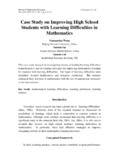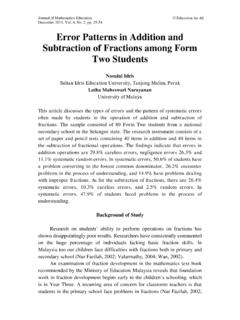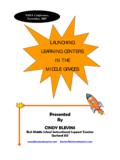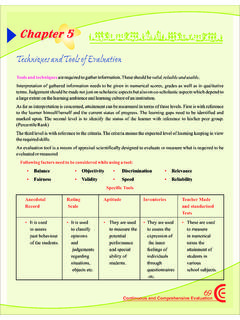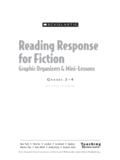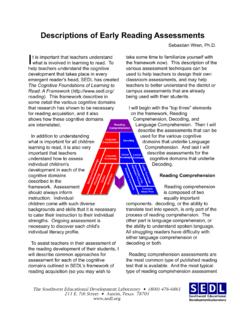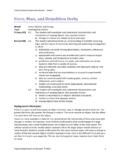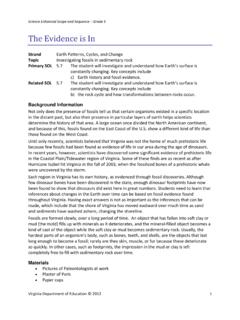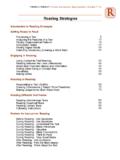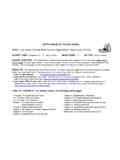Transcription of Mathematics Literacy: Are We Able - Education for All
1 Journal of Mathematics Education Education for All June 2011, Vol. 4, No. 1, pp. 89-100 Mathematics literacy : Are We able To Put The Mathematics We Learn Into Everyday Use? Bobby Ojose University of Redlands, It is common knowledge that most adults have a phobia with Mathematics . Was the way Mathematics was taught to them a contributing factor to the phobia? How much of the Mathematics that we learn in school are we able to use in our everyday life? What constitute Mathematics literacy ? What is the essence of Mathematics literacy ? What competencies are required for Mathematics literacy ? The answers to these questions are the focus of this paper.
2 Mention is made also of the nature of Mathematics . Key words: Mathematics literacy , Mathematics teaching, nature of Mathematics . Introduction Mathematics literacy does not imply detailed knowledge of calculus, differential equations, topology, analysis, linear algebra, abstract algebra, and complex sophisticated mathematical formulas, but rather a broad understanding and appreciation of what Mathematics is capable of achieving. This paper discusses what Mathematics literacy is; the essence of Mathematics literacy ; and the nature of Mathematics . It also discusses what constitutes Mathematics literacy and lists the competencies needed to attain Mathematics literacy .
3 It is important to note that the Mathematics we study and the Mathematics we need to know are two different things. The need to make this distinction rests with the fact that not every contents of Mathematics we have been exposed to as students can be applied in our daily lives as adults. The author sees an issue with many adults not being mathematically literate and presents a couple of actual scenarios that depict Mathematics illiteracy. This conversation has become necessary because Mathematics illiteracy that has registered deep in society affects all of us. According to Posamentier and Jaye Mathematics literacy 90 (2006), Mathematical deficiency seems to be common in our society and the Mathematics illiteracy is particularly alarming, especially in the context of our country s poor showing on recent international comparison tests (p.)
4 44). Mathematics literacy Defined Put simply, Mathematics literacy is the knowledge to know and apply basic Mathematics in our every day living. However, various authors have put an academic spin on what Mathematics literacy is. For example, The Organization for Economic Corporation and Development (OECD, 1999) defined Mathematics literacy as an individual capacity to identify and understand the role that Mathematics plays in the world, to make well-founded judgments, and to engage in Mathematics in ways that meet the needs of that individual s current and future life as a constructive, concerned and reflective citizen. Another meaning developed by The National Adult literacy Study, a project mandated by congress and carried out by the Educational Testing Service (ETS) in 1995, is that literacy involves using printed and written information to function in society, to achieve one s goals and to develop one s potential.
5 The study used three scales to quantify adult literacy : Pros literacy , Document literacy and Quantitative literacy ( Mathematics literacy ). Pro literacy includes the knowledge and skills to understand and use information in continuous texts such as editorial and news stories. Document literacy describes the skills and knowledge needed to locate and use information contained in a variety of document formats maps, schedules, payroll slips, entry forms, etc. Quantitative literacy refers to the skills and knowledge required to apply mathematical operations (arithmetic) to numbers embedded in printed formats. For example, completing an order form or balancing a checkbook are typical tasks requiring quantitative literacy .
6 The study s concept of adult literacy was heavily based on the use of Mathematics and emphasized the practical skills of everyday life. Some examples from the study tested Mathematics knowledge that ranged from Level I questions like Total a bank deposit entry to Level 5 questions like Use information in a news article to calculate the difference in time for completing a race. Of all the adults tested, 21% were found to be in the lowest level of pros literacy and 3% in the highest. The corresponding figures for documentary literacy were 23% and 3%. For quantitative literacy ( Mathematics literacy ), the figures were 22% and 4%. Based on these figures, one can infer that illiteracy in Mathematics and other kinds of illiteracies are Bobby Ojose 91 quite high.
7 The reader is encouraged to read the entire report and see for themselves the magnitude of adult illiteracy in Mathematics . An alternative conception of literacy , one that for other purposes may be more useful, is to characterize literacy in terms of the minimum knowledge and skill an individual would need to be considered literate in any given domain. While the definition of adult literacy in the ETS report speaks of knowledge that is needed, the knowledge that counts is clearly process knowledge rather than content knowledge- knowledge of how to do something rather knowledge of something. For example, an adult might know that calculating the Simple Interest of a deposited sum of money in a bank is: Principal x Time x Rate / 100.
8 But to actually crunch the numbers and arrive at an accurate answer requires another kind of knowledge and skill. The Essence of Mathematics literacy Mathematical literacy involves more that executing procedures. It implies a knowledge base and the competence and confidence to apply this knowledge in the practical world. A mathematically literate person can estimate, interpret data, solve day-to-day problems, reason in numerical, graphical, and geometric situations, and communicate using Mathematics . As knowledge expands and the economy evolves, more people are working with technologies or working in settings where Mathematics is a cornerstone. Problem solving, the processing of information, and communication are becoming routine job requirements.
9 Mathematics literacy is necessary both at work and in daily life. It is one of the keys to coping with a changing society. Mathematics literacy is as important as proficiency in reading and writing. Mathematics is so entwined with today s way of life that we cannot fully comprehend the information that surrounds us without a basic understanding of mathematical ideas. Confidence and competence in Mathematics leads to productive participation in today s complex information society and often opens doors of opportunities to those who possess them. Mathematics illiteracy, which is the inability to handle numbers and data correctly and to evaluate statements regarding problems and situations that invite mental processing and estimating, is a greater problem than our society recognizes.
10 According to Treffers (1991), this level of innumeracy might not be the result of content taught (or not taught) in schools but rather the result, at least in part, of the structural design of the teaching practices. Two examples of Mathematics illiteracy are highlighted below: Mathematics literacy 92 In 1990, a newspaper reported (Amsterdam Post, 1990, p. 8): Yesterday, Monday October 9, AVRO Television paid attention to analphabetism in The Netherlands. From data collected for the transmission, it appeared that no fewer than 1 out of 25 people cannot read or write. That is, cannot read or write a shopping list, cannot follow subtitles on TV, cannot read a newspaper, cannot write a letter.
